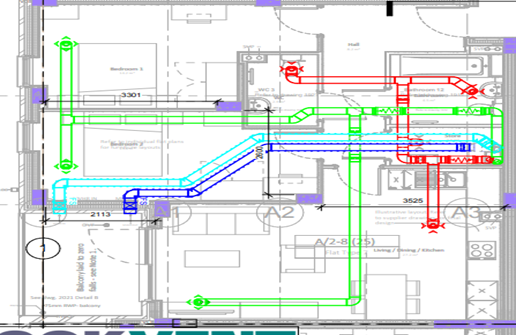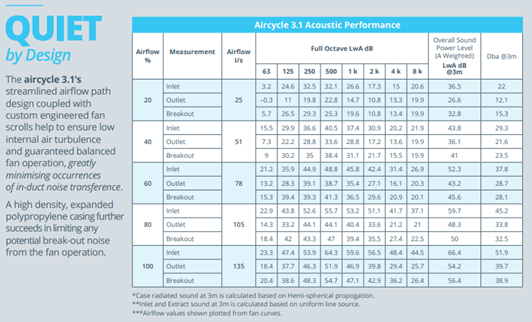Mechanical specifications are getting more and more stringent. And rightly so! One of the key factors when selecting an MVHR, or in fact any Mechanical Ventilation System, is to ensure when in operation it is compliant. Typically, this is outlined in a specification, there will be a defined NR or dB rating the system should achieve. The problem is that choosing the right MVHR doesn’t mean it will operate as efficiently, or in this case, as quietly, as it should. MVHR systems do create noise and everyone from the specifier to the installer plays a part in providing an MVHR system with appropriate attenuation.
What noise comes from the system, What makes a “loud” MVHR system? and How loud should a MVHR be?
If you are working on a project where the Specification doesn’t give you performance requirements, you’ll need to look at Approved Document Part F. The maximum noise level acceptable to comply with building control (Part F, England – 4.36) (Booklet K, NI – 2.37) is 30db for supply rooms and 35db for less sensitive extract rooms. This is when the system is in trickle mode.
https://www.gov.ie/en/publication/62f06-technical-guidance-document-f-ventilation/
What is loud? If we start with the measurable aspect, MVHR system sound is typically reported as a “Breakout”, (Noise made at the unit by its operation within a defined circumference; typically 3m) and “Inline” (Noise heard in the ventilated room from the air valve; typically 1-3m from the valve). System noise is manageable providing you have some insight into how the MVHR will be performing.
Three main ways to manage breakout are:
1) Size the system to be running at a relatively low specific fan power. Consultants and Specifiers can manage out this issue by ensuring that the project doesn’t allow MVHR’s to be running at capacity. This can be set by outlining performance criteria, detailing the acceptable noise levels of the system in its operation, or setting a max specific fan power when boosting. TDG Part F (Republic of Ireland) 2019 states that mechanical ventilation systems must provide a capacity of 25% above the general ventilation rate. This is of course relying on the specifier providing realistic system pressure calculations.
2) Location, location, location. Do not have an MVHR fitted where it backs onto or is directly above a habitable room or main bathroom. Noise perception is as important to the end user as the physical dB measure.
3) Consider the acoustic performance of the MVHR enclosure; making sure there is secure fixing (ideally with a ply lined or gable wall), ensure the MVHR is not touching any “boxing in” or other services and make sure the walls are appropriately insulated and doors are adequate and sealed. If an MVHR is fitted so snug that it is touching a boxed in SVP or other service, the cavity will act like an amplifier through the transition of vibration. On this note, Anti-Vibration brackets are an excellent solution to noise associated with breakout! By absorbing the residual vibration caused by the unit in operation, Anti Vibration Brackets stop any enhancement of the unit’s noise through vibration in the building structure. A system supported by only plasterboard or secured directly to a joist or rafter is at high risk of causing noise by vibration throughout a property.
Example of Breakout for our Aircycle 3.1.
https://staging.brookvent.co.uk/product/aircycle-3-1-house-ventilation-systems/
Inline Attenuation
Inline Attenuation is the reduction of noise through good design and the introduction of inline silencers (attenuators).
Three main ways to manage inline noise are:
1) Design and install attenuation correctly. Ideally attenuation should be applied to the index run before the 1st branch or Tee. Consult the manufacturer to ensure you are supplying the correct attenuators, and crucially the correct number of them to meet your specification. Remember it’s not just habitable rooms that may need attenuation.
https://staging.brookvent.co.uk/?s=attenuator
2) Install the ductwork well, and where possible install to the drawings. Where you must make changes consider if the attenuation is placed correctly first, and when you apply changes avoid using harsh bends. Go back to a designer if you have to. Make sure all joints are correctly sealed with screws, sealant, and tape (for rigid PVC systems). Install the ductwork drawn, if there’s sections of large duct drawn, it’s there for a reason.
https://staging.brookvent.co.uk/ducting-and-ancillaries/rigid-pvc-ducting/
Avoid flex! Flexible ductwork is great in small doses to get you from your duct to a valve, or to take some vibration out of the system from the spigots to the lateral ductwork. When this is used for bends, transitions or really anything over 300mm on a residential system, you will add resistance to your system, and you have created an area that may fail the system in the future (Perhaps when the Christmas decorations are thrown on top of the ductwork).
Air Valves should be sized for the correct airflow, if you have too much air at too fast a velocity passing to the air valve you will get a turbulent noise from the diffuser no matter how you balance the valves.
https://staging.brookvent.co.uk/product/pvc-air-valve-extract-supply-white/
3) Balance the system. It is important to have a qualified commissioner to finish the process. A well-designed system will allow all air valves to open and balancing the system shouldn’t be taxing. A well-balanced system will ensure that the MVHR isn’t running harder than it needs to keep the specific fan power low.
Cross Talk
Another inline issue is “Crosstalk”, this where sound is transmitted in low velocity air transfer between adjoining spaces. This occurs when adjoining rooms share a duct branch via a Tee. This tends to be designed out before install. If you do however come across this you can either add inline attenuation between the rooms, or ideally re-duct so that the two rooms branch at separate points from the index run. There is no easy way of achieving this in a finished property unless you are lucky enough to have access to the ductwork.
The more information provided at the early stage the more likely we are to have a well designed and quiet system. Brookvent can not only provide Technical Submission Documents showing exactly how our units perform under your design criteria, we can also assess your system pressure, design a quiet ducted system and specify type and size of attenuation to include in your system to meet your noise requirements.
Contact us at hello@brookvent.co.uk for any help or advice with your MVHR systems.









